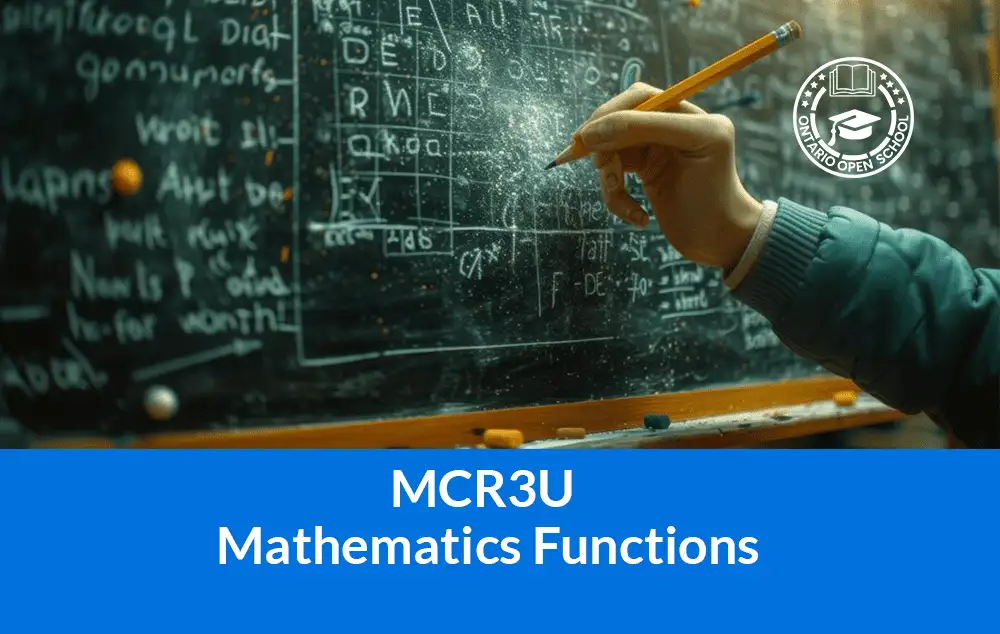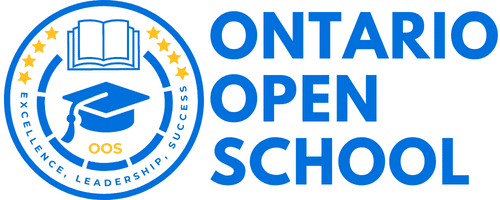- info@ontarioopenschool.com
- 647-494-4499
-
Unit 100 - 29 Gervais Drive, North York, ON.
M3C 1Y9
Copyright 2024 Ontario Open School Inc. All Rights Reserved.
This course introduces the mathematical concept of the function by extending students’ experiences with linear and quadratic relations. Students will investigate properties of discrete and continuous functions, including trigonometric and exponential functions; represent functions numerically, algebraically, and graphically; solve problems involving applications of functions; investigate inverse functions; and develop facility in determining equivalent algebraic expressions. Students will reason mathematically and communicate their thoughts as they solve multi-step problems.
Unit Order | Unit Name | Suggested Time |
|---|---|---|
| Unit 1 | Introduction to Functions Students will learn to identify a function as a special type of relation, recognize functions in various representations, and make connections between the algebraic and graphical representations of functions using transformations in this unit. They will also explore the properties of some basic functions and their inverses. | 10 Hours |
| Unit 2 | Quadratic Functions Students will learn to graph and analyze the properties of quadratic functions in this unit. They will also determine the zeros and the maximum and minimum of quadratic functions. In addition, they will solve problems involving quadratic functions, including problems arising from real-world applications. | 12 Hours |
| Unit 3 | Exponential Functions This unit will explore several topics including evaluating powers with rational exponents, simplifying expressions containing exponents, and describing properties of exponential functions represented in a variety of ways. The emphasis will be on problem solving using these concepts. | 22 hours |
| Unit 4 | Trigonometric Ratios In this unit, students will learn to relate the six trigonometric ratios to the unit circle, solve real-life problems by using trigonometric ratios, properties of triangles, and the sine and cosine laws. They will also learn to prove simple trigonometric identities. | 10 hours |
| Unit 5 | Sinusoidal Functions Students will be able to demonstrate an understanding of periodic relationships and sinusoidal functions, make connections between the numeric, graphical, and algebraic representations of sinusoidal functions, and solve problems involving sinusoidal functions, including problems arising from real-world applications in this unit. They will also understand the effect of applying transformations to the trigonometric functions. | 18 hours |
| Unit 6 | Discrete Functions: Sequences and Series This unit entails an exploration of recursive sequences and their representation in a variety of ways, an understanding of Pascal’s triangle and the relationships involved in arithmetic and geometric sequences and series. | 15 hours |
| Final Evaluation 30% | Final Assignment Final Exam
| 6 hours 2 hours |
| Total | 110 Hours |
A wide variety of instructional strategies are used to provide learning opportunities to accommodate a variety of learning styles, interests and ability levels. These strategies include, but are not limited to:
Purpose
The primary purpose of assessment is to improve student learning. Assessment relates directly to the expectations for the course.
A variety of assessments for and as learning are conducted on a regular basis to allow ample opportunities for students to improve and ultimately demonstrate their full range of learning and for the teacher to gather information to provide feedback. Assessment tasks relate to the success criteria set out in lesson plans. Success criteria allow students to see what quality looks like.
Evaluation is the process of judging the quality of student work in relation to the achievement chart categories and criteria and assigning a percentage grade to represent that quality. Evaluation is based on gathering evidence of student achievement through:
Assessment for Learning – we provide feedback and coaching. Assessment FOR Learning is the process of seeking and interpreting evidence for the use of learners and their teachers to decide where the learners are in their learning, where they need to go, and how best to go there.
Assessment as Learning – we help students monitor progress, set goals, reflect on their learning
Assessment AS Learning is the process of the explicit fostering of students’ capacity over time to be their own best assessors, but teachers need to start by presenting and modeling external, structured opportunities for students to assess themselves.
Assessment of Learning – we use assessments to provide evaluative statements about student achievement. Assessment OF Learning is the assessment that becomes public and results in statements of symbols
(marks/grades/levels of achievement) about how well students are learning. It often contributes to pivotal decisions that will affect students’ future.
ASSESSMENT TOOLS
Assessment and Evaluation Strategies for Student Performance
| Units | Duration | Overall Expectations | AFL | AAL | AOL | K
25% |
A
25% |
C
25% |
T 25% |
||
|
70% |
A | 25 hours | A1-A3 | Home Work
Worksheets Student-Teacher Conferencing |
Self-Assessment
Reflective Journal |
Test
Written Assignments |
√ | √ | √ | √ | |
| B | 25 hours | B1-B3 | Homework
Worksheets Student-Teacher Conferencing |
Self-Assessment
Learning Log |
Test | √ | √ | √ | √ | ||
| C | 30 hours | C1-C3 | Homework
Worksheets Student-Teacher Conferencing |
Self-Assessment
Learning Log |
Test Written Assignments |
√ | √ | √ | √ | ||
| D | 30 hours | D1-D3 | Homework
Worksheets Student-Teacher Conferencing |
Self-Assessment
Reflective Journal |
Assignments | √ | √ | √ | √ | ||
| 30% | A1-D3 | and Final Exam 30% (Written Component) |
√ |
√ |
√ |
√ |
|||||
Resources
http://www.edu.gov.on.ca/eng/policyfunding/growSuccess.pdf
Grading
Weighting of categories
| Knowledge/Understanding | Thinking/Inquiry | Communication | Application |
| 25% | 25% | 25% | 25% |

Course Grade | Grade 11 |
|---|---|
Course Code | MCR3U |
Course Category | Mathematics |
Course Type | University Preparation |
Course Delivery | Online |
Course Duration | 110h |
Course Credit | 1.00 |
Copyright 2024 Ontario Open School Inc. All Rights Reserved.
